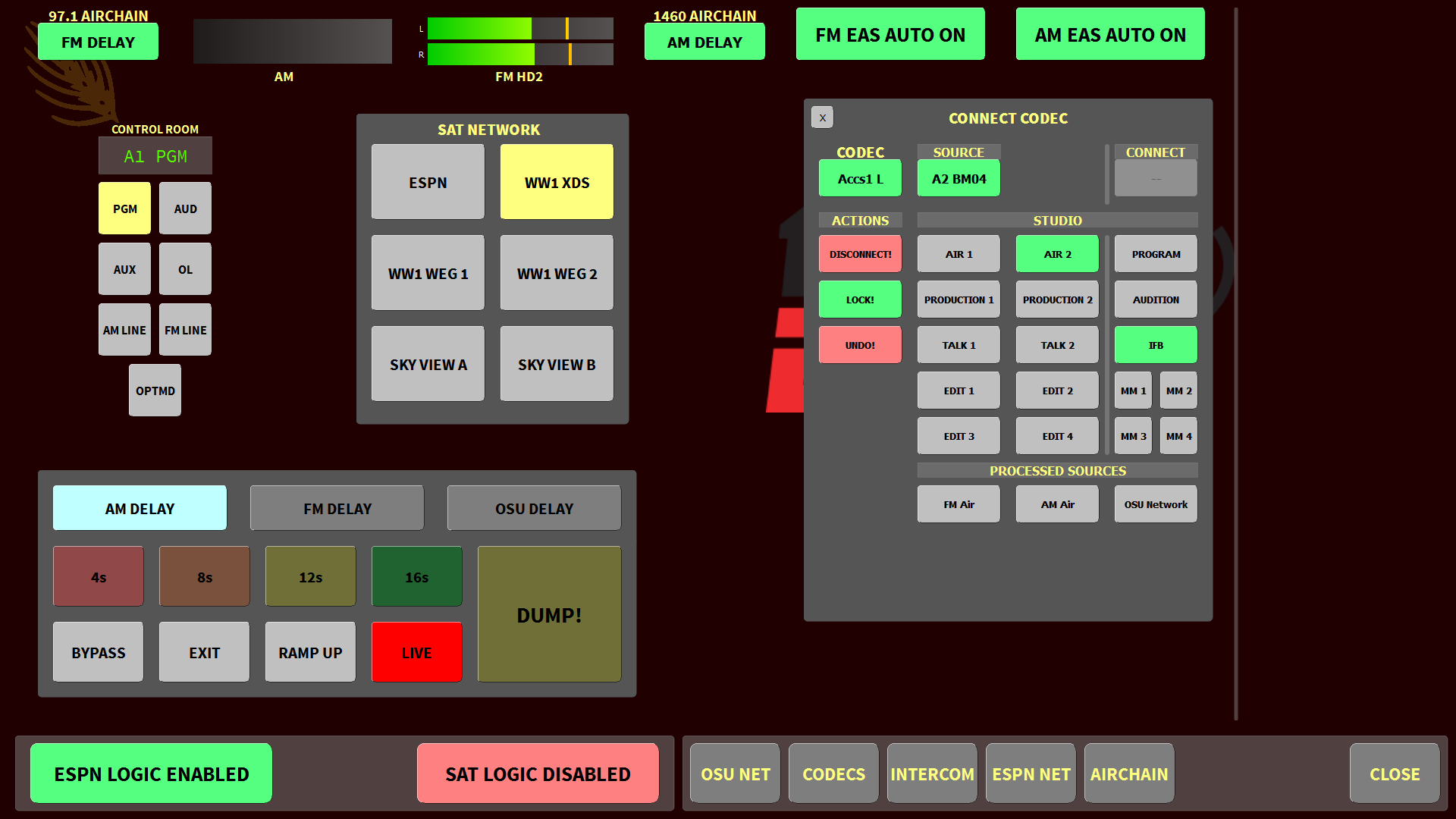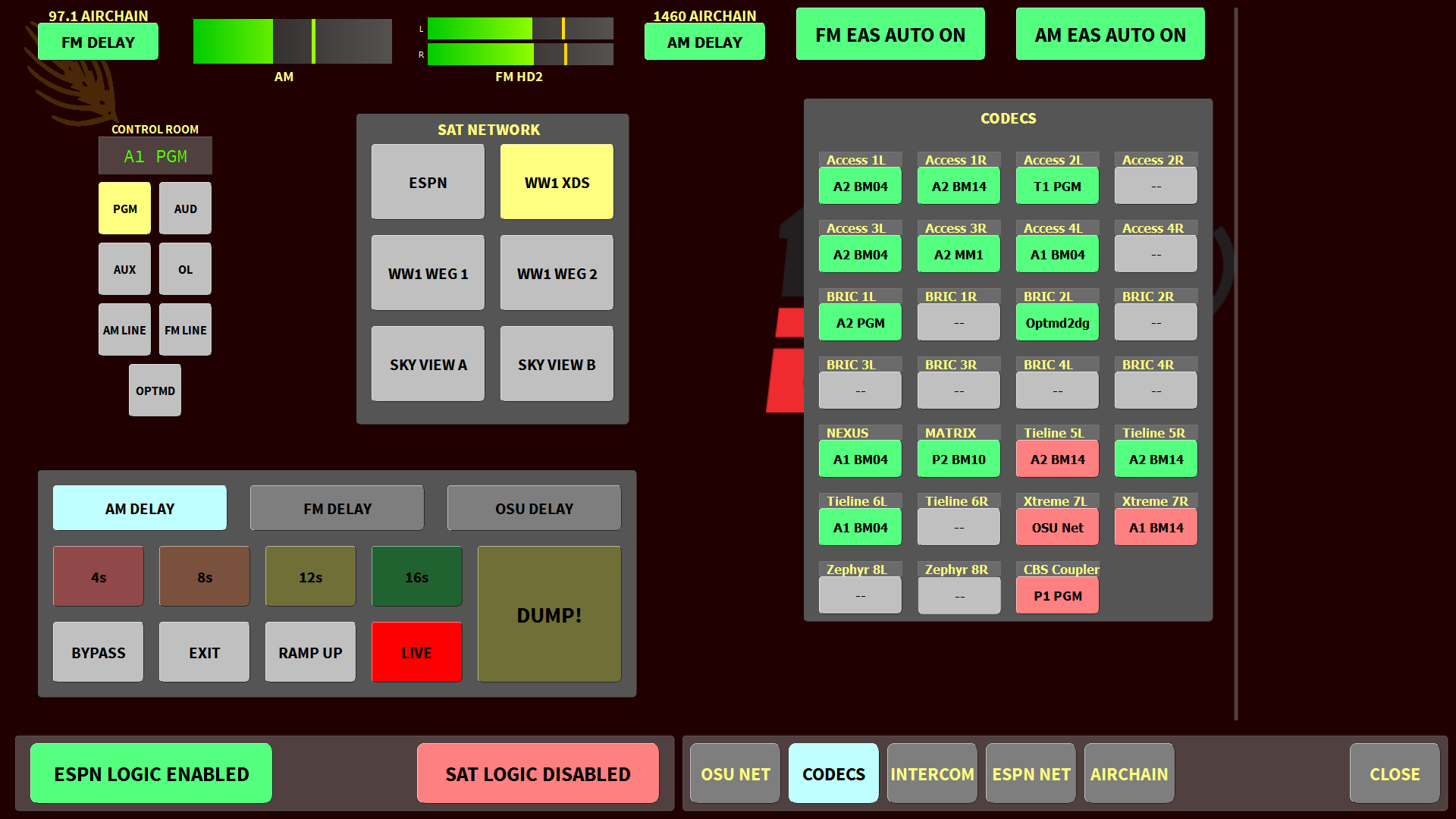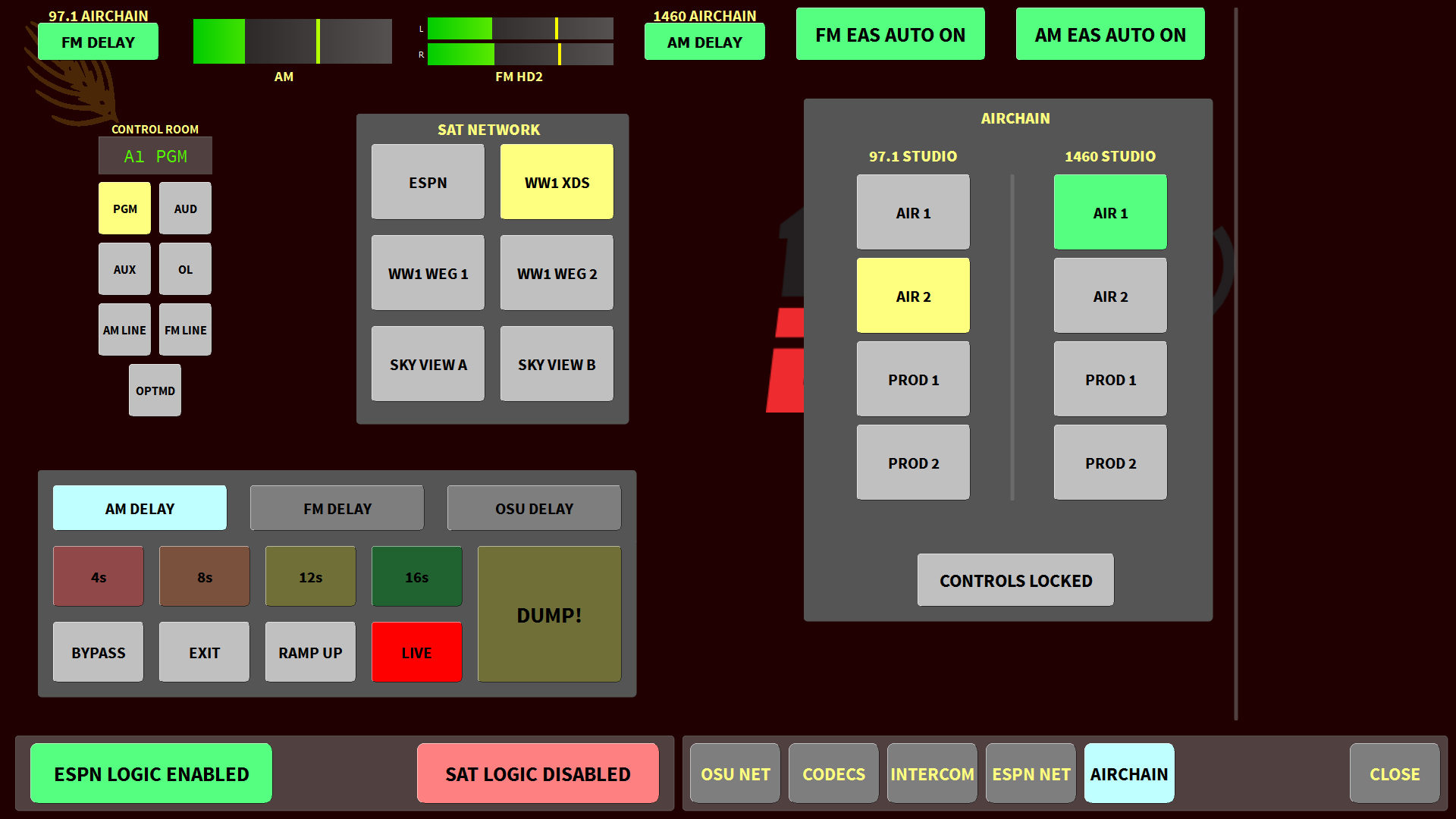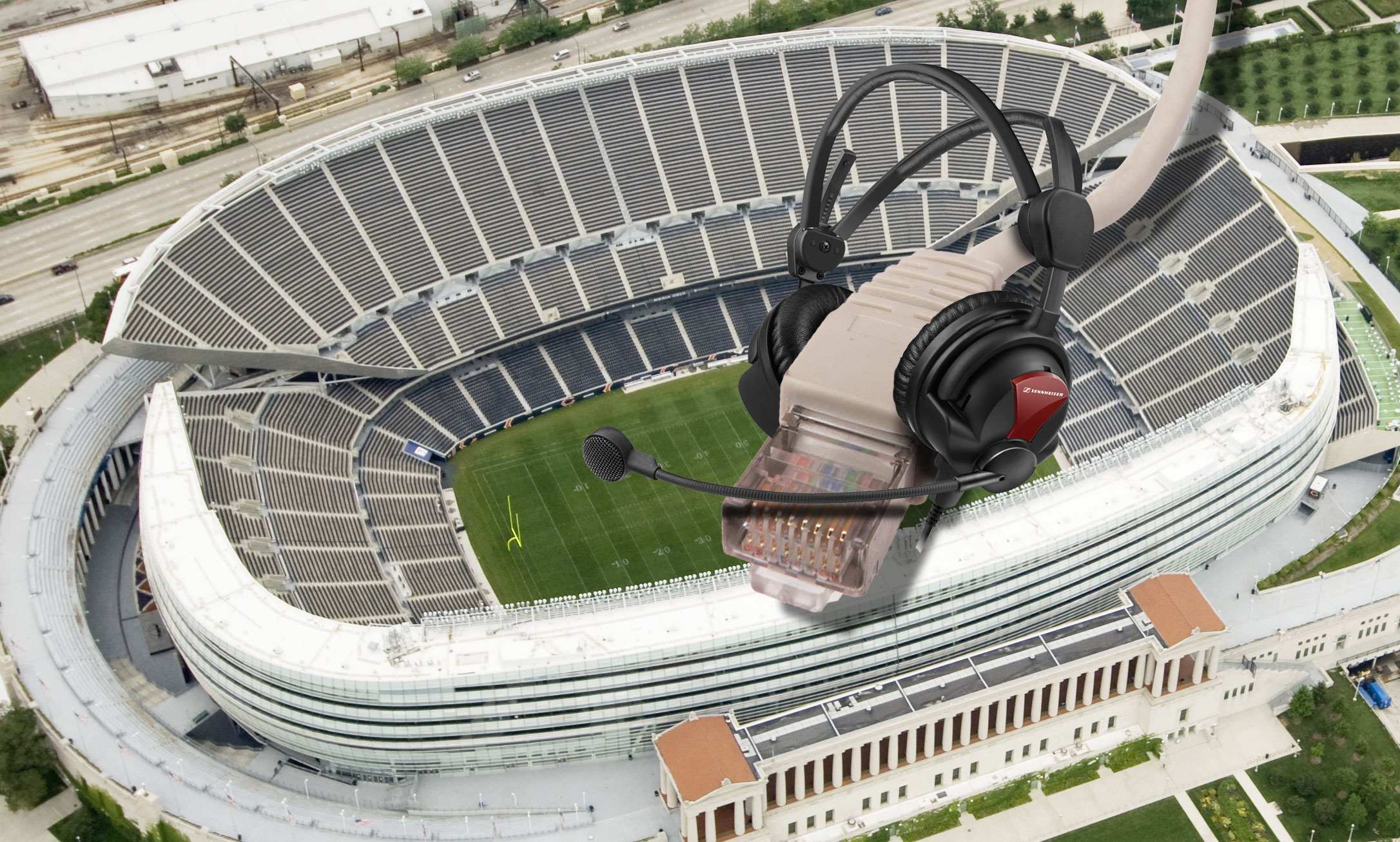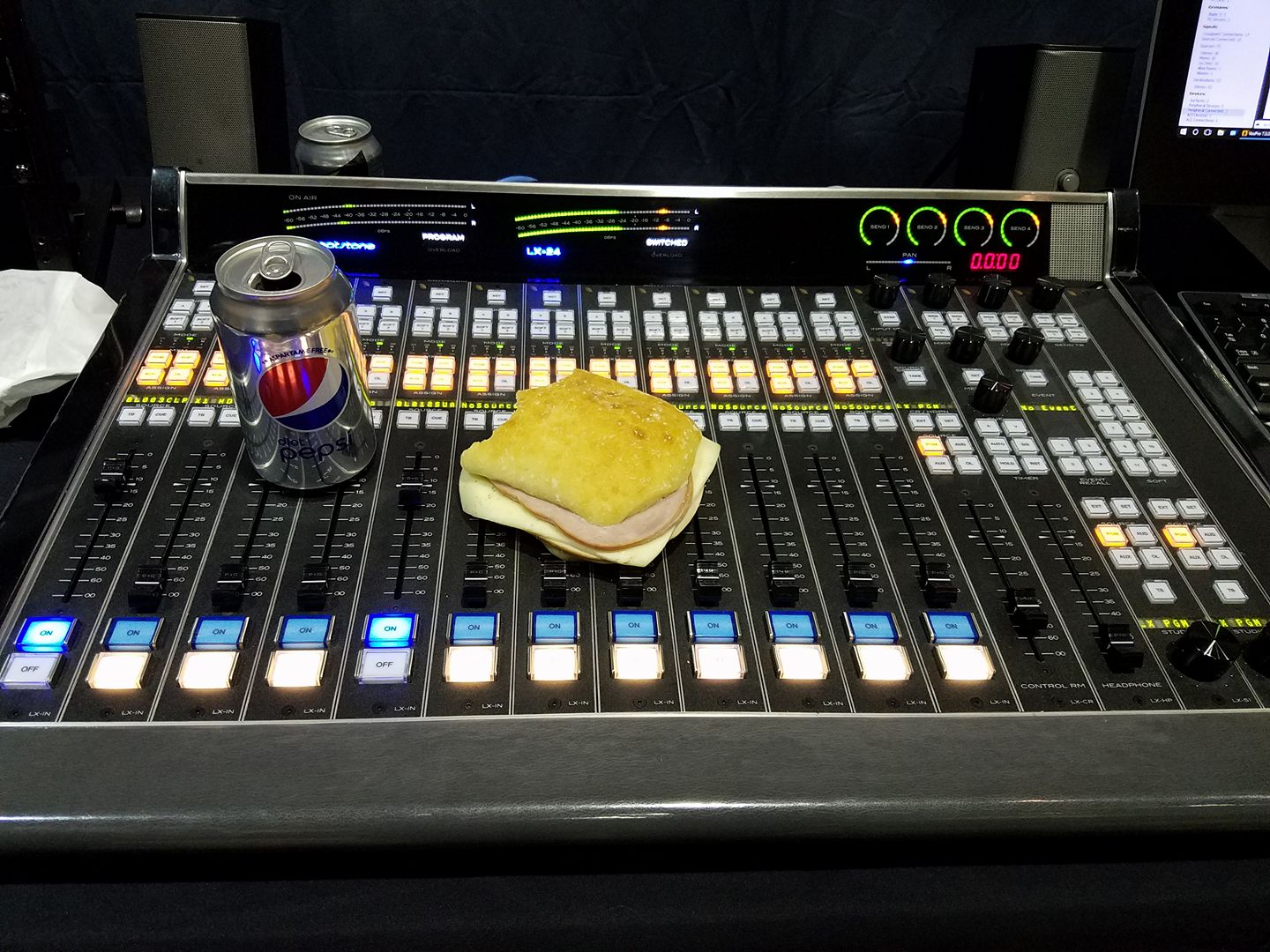WHEAT:NEWS RADIO
October 2017
Vol 8, No10
Got feedback or questions? Click my name below to send us an e-mail. You can also use the links at the top or bottom of the page to follow us on popular social networking sites and the tabs will take you to our most often visited pages.
RadiOhio on Touchscreen
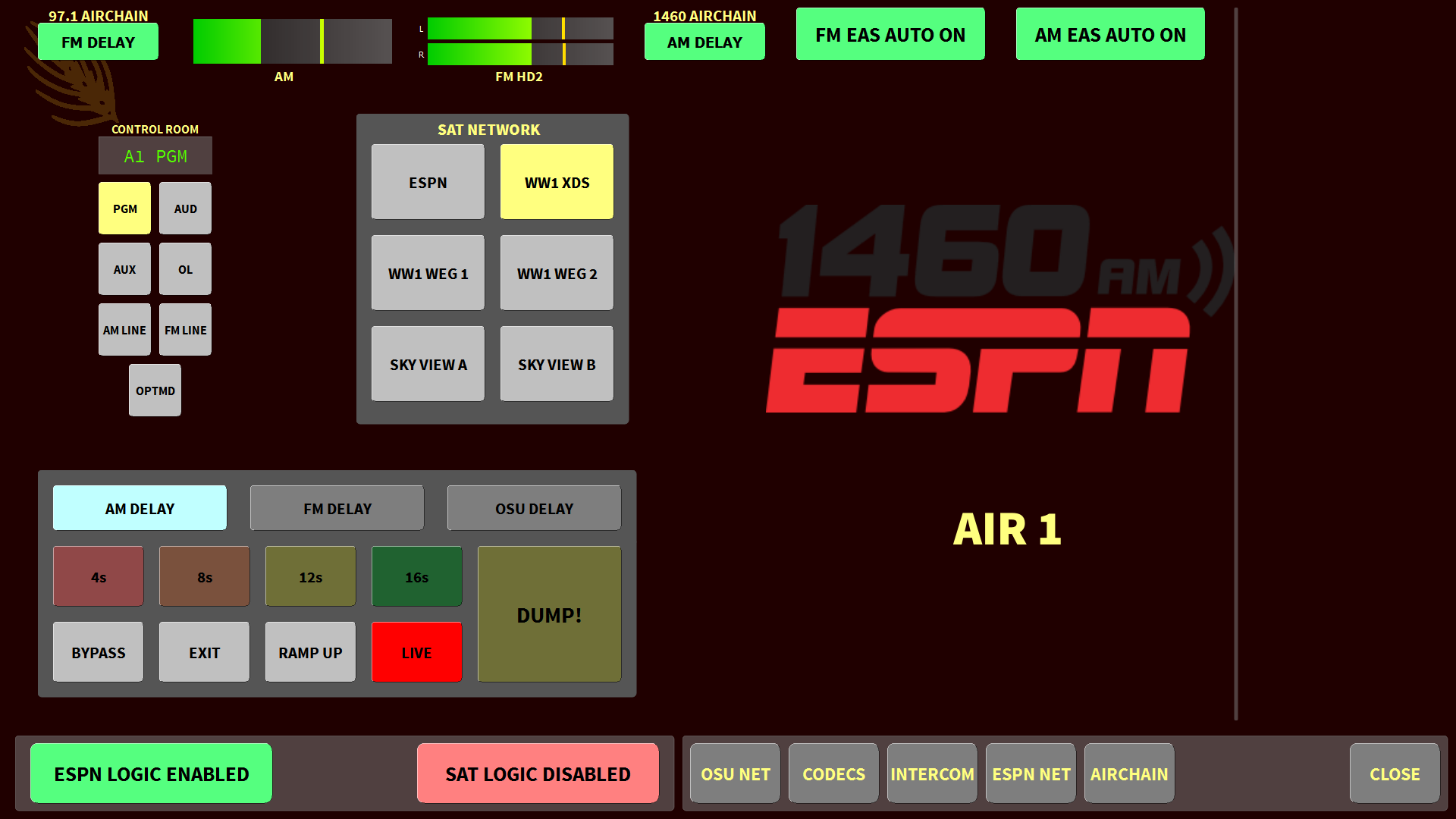 The worldview from inside RadiOhio in Columbus, Ohio, can be summed up in a simple touchscreen interface that sits alongside the console in every studio. It is through this that talent are able to talk directly to just about everything that touches the WheatNet-IP audio network – LX-24 consoles, codecs, profanity delay, transmitter readings, and more.
The worldview from inside RadiOhio in Columbus, Ohio, can be summed up in a simple touchscreen interface that sits alongside the console in every studio. It is through this that talent are able to talk directly to just about everything that touches the WheatNet-IP audio network – LX-24 consoles, codecs, profanity delay, transmitter readings, and more.
This new window into the everyday operation of radio is made possible because of RadiOhio Director of Engineering Greg Armstrong, Staff Engineer Tyler Stark, and ScreenBuilder, an app that ties elements on the network to onscreen buttons, meters, and other widgets.
Behind the Screens
Like many broadcasters, Armstrong started out with physical button panels to make things happen on the network. Then, “We offloaded a lot of those functions onto ScreenBuilder because we could do a much better display and give the operator a lot more information than we could with the GP panels.”
Armstrong quickly discovered that many of the subroutines he used for blinking physical buttons on or off, for example, were directly transferable to ScreenBuilder. “Some of the code used for the GP panels proved to be helpful in building the screen interfaces,” he said.
ScreenBuilder is a WheatNet-IP audio network app for arranging virtual faders, meters, labels, buttons, clocks, timers, and other widgets on a touchscreen interface for controlling and monitoring. Widgets are drag and drop, and users can assign values to each widget for controlling or monitoring any aspect of the WheatNet-IP environment, including third-party gear.
In many cases, Armstrong was able to cut and paste logic routines and expand upon them for his own purposes. “We‘re doing a lot of logic. We’re getting statuses from the outside world and we’re doing a lot of internal Wheatstone functions, like asking what’s connected to a particular destination and stating things like, ‘If the GPIO for EAS is routed, I want the lamp to light up green, but if it’s not routed, light the lamp red.’
“It’s not just clicking and tying a button to something. We’re getting into the network and asking it questions,” he added.
Talent in the AM and FM control rooms have total control over program channels, satellite feeds, profanity delays, IFBs, and remote codecs through this interface, courtesy of Director of Engineering Greg Armstrong and WheatNet-IP ScreenBuilder.
On the left side of the screen are all the necessary buttons for control room buses and routing sources, as well as indicators showing the status of the return feed from the modulation monitor and the FM audio processor. RadiOhio automates satellite programming from ESPN, Skyview and Westwood One, all of which come into the LX-24 console through a BLADE utility mixer. Talent can select which satellite feed is routed to the mixer and view the status of that feed, whether it’s audio only (yellow) or audio and logic (green).
Indicators tell them whether the logic for ESPN or other satellite program is enabled to trigger the ENCO automation.
In the past year, RadiOhio updated to Eventide profanity delay units with WheatNet-IP audio inside. Armstrong centrally located the units in master control and built widgets on ScreenBuilder for operators to control the delays from any studio.
Hidden on the right side of the screen is an annunciator panel of indicators (not shown here; see fig. 4) that will flash in the event of a NOAA weather alert or if the AM or FM goes silent for any reason.
Fig. 2A left Fig 2B right, Putting codec selection and IFB routing onscreen markedly reduces the time and complexity of setting up remotes by talent, in particular having to change the fold back on the IP codecs shared by the primary AM studio and the primary FM studio. Instead of having to open a cross point on the network and change the codec to the correct bus-minus, they now select codecs from a menu on the right (see Figure 2B) and the system scans the console inputs to find out which channel the codec is sitting on and assigns the appropriate bus-minus.
Talent can easily select which studios are tied to which air chain by first pressing the “controls locked” button twice, which reduces the chance of someone making an unintentional change that could result in dead air. “For all our critical controls, we make it so they have to press the button once, and then again to unlock the controls. If they don’t press it that second time within three seconds, it defaults to locked,” explained Armstrong.
Instead of a physical button panel for AUX and PGM in each talk studio, these can be selected onscreen along with the air studio they’re tied to.
Shown is a screen for setting up intercoms.
RadiOhio’s The Fan 97.1 originates college sports programming to 80-some affiliates nationwide and broadcasts ESPN programming to local listeners. When the station's ENCO fires a local break relay or ID to the affiliates, announcers receive a visual confirmation that the affiliate has received the relay. A button on the lower left of the screen that is tied to the LIOs coming out of the satellite receiver changes from green to yellow and then to red to indicate that the relay has been received. Relays also can be fired directly from the screen, should the announcer need to bypass the ENCO system, and profanity delay for the sports network is floating as a separate function tied to the sports network so that it can be activated no matter which studio the sportscast originates from.
Fig. 4 This image is of the “hidden” annunciator buttons on the right side of the main screen that flash when active.
What’s Armstrong’s advice for other broadcasters wanting to virtualize some of their stations’ functions? Armstrong suggests they start with Wheatstone’s Script Wizard, which is a standard coding framework for the logic commands used throughout the network. “Script Wizard is a good place to start. Have a look at the auto-generated code, and then once they understand some of the basics they can go on to do all kinds of things,” he explained.
Take Me Out to the Ballgame
There aren’t too many broadcast related problems that a little WheatNet-IP audio network BLADE can’t solve, especially when it comes to remote production.
Audio. It’s on the network. No need to ship an additional mixer to the sports stadium or other remote venue, along with a board op to operate it. Instead, feed mic or camera audio into the network on location and mix or process it at a booth or production truck nearby, or at a studio miles away. Audio is fed into BLADEs in the field, and can be aggregated with video over a broadband link and sent to a production truck or centralized studio for final production.
Wheatstone has specialized BLADEs for feeding audio from mics, line level, AES, MADI, AES67 and HD-SDI sources. For example, the IP88-3M BLADE has eight mic inputs and preamplifiers with pad, phase switch, and phantom power in one rack unit. Another BLADE, the M4IP-USB mic processor BLADE, is a four-channel mic processor with high-quality, low-noise, high-dynamic range and accurate transient response in an IP networked rack unit.
Mixing, also on the network. Background mixing can now happen independently from the console surface, like so many other functions resulting from IP audio networking. Each of the I/O BLADEs that make up the connection points in the WheatNet-IP audio network include full-featured virtual stereo mixers. The inputs and output buses of these mixers are available as resources on the network and can be used to mix-down or split channels onsite at, say, a sporting event, or for creating an intercom system.
IFB? That too. Need a quick intercom between the director in the booth and the announcer on the field? The WheatNet-IP audio network of BLADEs can serve as an IFB backbone by simply triggering cross points in the network – with zero latency between crews on location. Mix-minus, routing and control built into BLADEs can be triggered in the field from a button panel or from an IP audio console in a booth, production truck or centralized studio. An operator at the head end can push a button to make an IFB connection, yet the audio stays local so there is no noticeable latency on location.
Crowd noise at the stadium. The network has it. That same M4IP-USB BLADE used to feed audio from the announcer’s mic at the ballgame can be used to process audio feeds. Apply dynamic EQ, compression, limiting, gating, high and low pass filters in the field. And because it’s part of the network, audio conditioning can be controlled in the field and at the head end. Too much crowd noise can be fixed immediately on location or it can be done back home at the studio. IP audio networking is why.
Network without limits. WheatNet-IP audio BLADEs are AES67 compatible, which means you can now transport audio from, say, a live sound group that might have one network platform (such as a WheatNet-IP system) and a remotely located production facility that has another (such as Dante®).
Your IP Question Answered
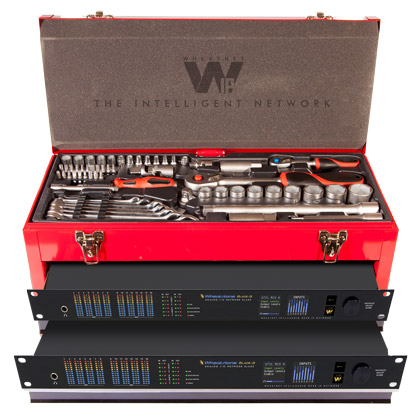
Q: We’ve been thinking a lot about studio redundancy and failsafe measures given the recent rash of hurricanes. What can you tell us about WheatNet’s distributed network configuration?
A: Being in North Carolina, we think about those things too! That’s why we’re a fan of distributed networking and decided to go this route when designing the WheatNet-IP audio network. Distributed networks are exactly what the name implies: distributed resources throughout the network. Distributed networks like our WheatNet-IP automatically build in redundancy because if one part of the network fails for any reason, the rest can keep on functioning.
Each IP connection point – or BLADE – stores not only its configuration but also the entire configuration of the network onboard, which means that failover is immediate. We sleep better at night knowing that our BLADEs are on the job.
Download Our Free E-Book:
Advancing AoIP for Broadcast
Putting together a new studio? Updating an existing studio?
We've put together this e-book with fresh info and some of the articles that we've authored for our website, white papers, and news that dives into some of the cool stuff you can do with a modern AoIP network like Wheatstone's WheatNet-IP.
And it's FREE to download!
Caption This!
Jim Gray (Optimized Media Group) posted this picture on Facebook of the LX-24 at the Wisconsin Broadcasters Association conference earlier this month, which people captioned with comments like “Ham and cheese on Wheatstone” (Brian Freeman), “What Could Possibly Go Wrong?” (Shawn D Jeske) and “The best food tray!” (Avi Banon).
True Confessions of a Morning Host
 We’re always interested in what goes on inside the mind of a morning radio host.
We’re always interested in what goes on inside the mind of a morning radio host.
We talk often to VoxPro power users like Jay Turner, the PD and morning show host for Sunny Country, KSNI-FM, in Santa Maria, Calif. Sometimes, we talk about what’s happening in the news. Other times, Jay gives us valuable input on our digital recorder/editor. In fact, we added at least one feature to the VoxPro version 7 at Turner’s request. You can thank Jay for being able to easily edit channels independently should, say, a caller or jock talk over the other. (Click to view the video)
But most of the time we talk about the industry, and about things like TSL and ratings.
For the record, Jay doesn’t see the quarter-hour spot block going away anytime soon, but he doesn’t necessarily stand on convention when it comes to the right-now mentality of today’s listener. “If someone calls in with traffic update, we don’t wait until after the spot block. We come in with that right after the song because they can get that on their phone. We’re competing with the phone in many ways, so we have to be there with those kinds of updates,” he said.
The last time we talked to Jay, he was working on a True Confessions program segment and experimenting with VoxPro to get that gravelly voice that jocks seem to like.
Talking with Jay makes for some good conversation…and products.
Processing: Where’s it All Going?
 You can’t tell where you are going unless you know where you are. True enough. We wanted to know where all this new audio processing technology is taking us, so we sat down with Mike Erickson during a rare moment when he was in between flights and asked a few questions.
You can’t tell where you are going unless you know where you are. True enough. We wanted to know where all this new audio processing technology is taking us, so we sat down with Mike Erickson during a rare moment when he was in between flights and asked a few questions.
WS: What’s the buzz right now in processing. What are people looking for?
ME: People have always looked for value, but now more than ever we are seeing more value built directly INTO processing. 15 years ago people thought paying $3500 for what was essentially a stripped down FM audio processor was a great deal, even though that processor often left a lot to be desired because features had been left out to save costs. Today a $3500 processor can be extremely sophisticated, with value added options like RDS, AOIP, AES67, baseband192 and intelligent audio management included at no extra charge.
WS: What kind features make the most sense to users?
ME: For budget priced processing, we see customers who want it to be simple to operate with options they will actually use every day. There’s a lot of marketing options added to some processors that don’t trickle down to practical use in the real world. We try and avoid that and focus more on improving the actual sound of the box with these added features that are requested by customers.
In our larger boxes, customers are looking for insert points for PPM watermarking as well as a processor that will wear many hats and behave more like an audio management system at their transmitter site.
WS: What can you tell us about the new AirAura X4? How does that play into the audio management angle?
ME: We’ve purposely spent quite some time on the development of the X4; there are many features in the unit that help with the audio management angle that are both practical and easy to use. An insert point for ratings encoders is a given for any top-of-the-line processor today. We also have a built in HD/FM tuner that will automatically align the analog and HD audio for seamless blending in fringe reception areas. Another first is something I’m very excited about, and that’s automatic logging. Users will now be able to see a date/time stamp on preset changes, audio source changes and remote logins. It will be a valuable tool for customers who may be troubleshooting an audio issue.
WS: So if the main audio path goes away, the processor will switch AND log the incident?
ME: Correct. You will know the exact time the audio signal switched to the backup audio path AND the time it switched back.
WS: I’m surprised it took so long to see something like this in an audio processor?
ME: In a way I am as well, but it’s actually something I’ve been thinking about for nearly a decade from my time at CBS. We’ve been able to time and date stamp events in an audio router, why not the processor?
WS: What sets X4 apart, other than the added features?
ME: You’ve got some very powerful new audio algorithms that not only work with EVERY receiver on the market, they excel far beyond what others can offer. In other boxes on the market, I can add loudness on some receivers by manipulating the baseband to make up for deficiencies in basic clipper design, but not every radio is compatible with these methods. X4 is compatible with every receiver on the market today and tomorrow… and is even further compatible with every HD/FM receiver out there by means of its automatic time alignment.
WS: X4 is not the only project on your desk….
ME: Nope. FM55e is also coming along. The front end has been completely redone and takes this processor beyond the next level. Early feedback from some beta users has indicated that 55e outperforms some of the flagship boxes of competitors not only sonically and consistently but with ease of setup.
WS: All in a box for about $3500?
ME: Yes. The FM55 was a new platform for us and we built that processor to stand on its own merits. It was never about removing features from a flagship box to make a budget box, it was about new ideas that were efficient and new hardware that could pull this off with ease. Like all of the processors we have ever made, the FM55 was designed with power to expand in the future and now users will see that expansion with a free update to the FM55e platform.
WS: After X4 and FM55e, what’s next?
ME: Lots more. But you’ll have to see us next April in Las Vegas!
Mike Erickson’s official title is Wheatstone Audio Processing Systems and Support Engineer. Mike travels around the U.S. and abroad to help set up audio processing for stations, and is probably the closest you’ll ever come to meeting an audio processing roadie.
VIDEO: How to Set Up the PR&E DMX
The new PR&E DMX is starting to make its way into studios. Our own Scott Johnson, with a camera in one hand, shows you how to set it up and get it going with the other!
Part One: Physical Setup
Part Two: Getting Audio Running
Good News for Radio
Radio survived the tape, CD, and iPod. In the age of Spotify, it’s more popular than ever.
More advertisers will increase their radio budget than cut it
Radio on Phones, Please
Hurricanes show need for radio-enabled smartphones

Wheatstone
-
Soundfusion (Johannesburg, South Africa) purchased four IP-12 digital audio consoles.
-
Sambhaav Media (Ahmedabad, India) purchased four IP-12 digital audio consoles and eight Air-1 consoles through Horizon Broadcast.
-
Odisha TV (Odisha, India) purchased an IP-12 digital audio console through Horizon Broadcast.
-
KBIA-FM (Columbia, MO) purchased two L-8 control surfaces and three M4IP-USB four channel mic processor BLADEs.
-
WATV-AM (Birmingham, AL) purchased a WDM audio driver through Bohn Broadcast.
-
KAFE-FM (Bellingham, WA) purchased an IP-12 digital audio console.
-
Rogers Broadcasting (Kitchener, ON) purchased console accessories through Ron Paley Broadcast.
-
Rogers Broadcasting (Toronto, ON) purchased an I/O BLADE through Ron Paley Broadcast.
-
CHIN-AM/FM (Toronto, ON) purchased WheatNet-IP audio network Scheduler software through Ron Paley Broadcast.
-
Duke University’s WXDU-FM (Durham, NC) purchased an IP-16 digital audio console and E-1 control surface.
-
Saga Communications (Charleston, SC) purchased two L-8 control surfaces.
-
WGN-TV (Chicago, IL) purchased three I/O BLADEs for an existing WheatNet-IP audio network.
-
WDWS-AM (Champaign, IL) purchased three EDGE network units to extend an existing WheatNet-IP audio network.
-
Atlanta Braves Network (Atlanta, GA) purchased seven TS-4 talent stations for an existing WheatNet-IP audio network.
-
CBC Radio (Edmonton, AB) purchased a split-frame E-6 control surface through Ron Paley Broadcast.
-
Five Towns College (Dix Hills, NY) purchased two I/O BLADEs and a ScreenBuilder app for an existing WheatNet-IP audio network.
-
CBC Radio (Montreal, QC) purchased a TS-22 talent station, I/O BLADE and WDM audio driver for an existing WheatNet-IP audio network through Ron Paley Broadcast.
-
CJPE-FM (Picton, ON) purchased an IP-12 digital audio console and NAVIGATOR 3 software through Ron Paley Broadcast.
-
KFJB-AM (Marshalltown, IA) purchased IP-12 and IP-16 digital audio consoles with WheatNet-IP audio network I/O BLADEs.
-
Townsquare Media (St. Cloud, MN) purchased thirteen I/O BLADEs and audio drivers for an automation upgrade project.
-
Hubbard Broadcasting (Seattle, WA) purchased a WDM audio driver for an existing WheatNet-IP audio network.
-
Leighton Broadcasting (St. Cloud, MN) purchased a ScreenBuilder app for an existing WheatNet-IP audio network.
-
Townsquare Media (Evansville, IN) purchased six OLED control panels for an existing WheatNet-IP audio network.
-
Skyview Networks (Scottsdale, AZ) purchased an I/O BLADE and WDM audio driver for an existing WheatNet-IP audio network.
-
CBS Radio (Colton, CA) purchased a ScreenBuilder app for an existing WheatNet-IP audio network.
-
Crocmedia (Melbourne, Australia) purchased an E-1 control surface.
-
Delmarva Educational (Jacksonville, FL) purchased a DMX console through SCMS.
-
Telestar Communications (Sydney, Australia) purchased six DMX consoles.
-
Entercom (Charlotte, NC) purchased thirteen I/O BLADEs and audio drivers for an automation upgrade project.
Audioarts Engineering
-
Townsquare Media (Danbury, CT) purchased an Air-4 console.
-
WXCZ-FM (Cedar Key, FL) purchased an Air-4 console.
-
WNKR-FM (Cincinnati, OH) purchased an Air-5 console.
Wheatstone Audio Processing
-
Evanov Radio (Halifax, NS) purchased an M4IP-USB four channel mic processor through Ron Paley Broadcast.
-
Blackburn Radio (Wingham, ON) purchased an AM-55 audio processor through Ron Paley Broadcast.
-
Oakwood Broadcast (Mississauga, ON) purchased an FM-55 audio processor.
-
Townsquare Media (Reno, NV) purchased an M4IP-USB four channel mic processor BLADE.
-
Beasley Broadcast Group (Tampa, FL) purchased an AirAura X3 spectral audio processor and AirAura X1 audio processor.
VoxPro
-
Radio One (Dallas, TX) purchased a VoxPro 7 digital audio recorder/editor.
-
iHeartMedia (Boston, MA) purchased three VoxPro 7 digital audio recorder/editors.
-
CBS Radio (Colton, CA) purchased two VoxPro 7 digital audio recorder/editors.
-
CJJR-FM (Vancouver, BC) purchased a VoxPro 7 digital audio recorder/editor through Ron Paley Broadcast.
-
CBS (Phoenix, AZ) upgraded to four VoxPro 7 digital audio recorder/editors.

